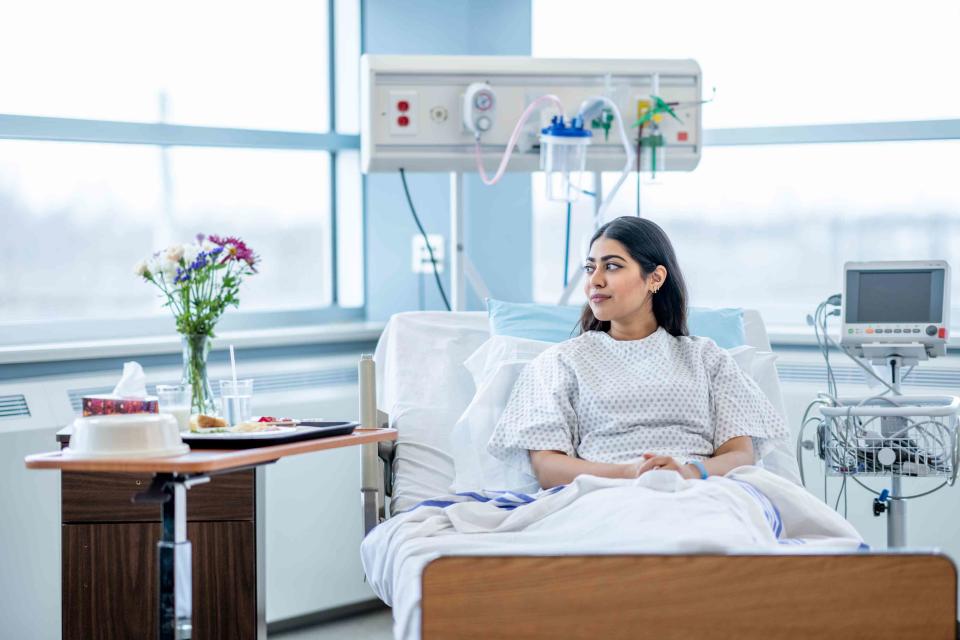Endometriosis Surgery
Laparoscopy for endometriosis is the gold standard for treatment

FatCamera / Getty Images
Medically reviewed by Monique Rainford, MD
Although endometriosis is not curable, pain and infertility caused by the condition can be improved with laparoscopic surgery, which is considered the gold standard for treatment. Laparoscopy is usually well tolerated and is an effective surgery for removing endometriosis patches.
This article discusses the types, recovery, success rates, and financial considerations of endometriosis surgery.

FatCamera / Getty Images
When to Have Endometriosis Surgery
Endometriosis affects up to 11% of women of reproductive age. Treatment can include lifestyle changes, oral medications, physical therapy, and surgery. Nonsurgical medical management is used upfront to decrease the progression of endometriosis and reduce symptoms. Surgical intervention may be needed in the following circumstances:
Undiagnosed pelvic pain: Your healthcare provider may diagnose you with endometriosis based on symptoms alone. Other times you may need laparoscopic surgery to help confirm.
To improve fertility outcome: Endometriosis surgery may improve the odds of becoming pregnant if combined with assisted reproductive technology (ART).
Pain that continues after surgery: Recurrence of pelvic pain within two years after surgery can occur in 8 out of 10 women, requiring further surgical workup.
Other symptoms of endometriosis that aren't improving with medication, like heavy bleeding, chronic constipation, difficulty urinating, or scar tissue formation, may also warrant surgical removal of endometrial-like lesions.
Is Endometriosis Surgery a Major Surgery?
How well you tolerate endometriosis surgery depends on the type of surgery, the extent of the condition, and your current health. Most endometriosis surgeries are minimally invasive (laparoscopy).
If the endometriosis is extensive, your healthcare provider may decide to perform a laparotomy, which involves making a large incision across your abdomen. However, nowadays, laparotomies are rarely done for endometriosis. People with comorbidities (co-occurring health conditions) like high blood pressure, diabetes, or obesity may have a more complicated surgery with a longer recovery.
Types of Endometriosis Surgery
Endometriosis surgery is categorized as either conservative or definitive. Conservative surgical techniques involve excising the endometriosis patches to conserve organs and fertility, whereas definitive surgical interventions remove organs affected by endometriosis. Types of endometriosis surgery include:
Laparoscopy: Laparoscopy helps diagnose and remove endometrial-like lesions; ablation can also be performed.
Laparotomy: Laparotomy is major abdominal surgery that helps to better visualize and remove extensive endometriosis patches that may be invading other organs.
Hysterectomy and oophorectomy: Hysterectomy is surgery to remove the uterus, while oophorectomy is surgery to remove the ovaries.
Related:Endometriosis Excision Surgery: What Happens and Recovery
Surgical Techniques in Removing Endometriosis Matters
During laparoscopic excision or ablation, a surgeon makes several small incisions in the abdomen compared to a single large incision. Laparoscopy is usually a well-tolerated procedure, with a short hospital stay and minimal risk of infection.
Laparoscopic Excision
A laparoscopic excision involves a surgeon excising (cutting off) the endometriosis patches using laparoscopic instruments. The endometrial-like tissue is removed through one of the incisions.
Laparoscopic Ablation
During laparoscopic ablation, a surgeon uses laser or energy-generating heat to burn and destroy the lesions. Care must be taken not to damage the healthy tissue or organs surrounding the endometriosis patch.
How Successful Is Endometriosis Surgery?
Endometriosis surgery is successful for most people. Sometimes those with moderate to severe pain report better postoperative outcomes than those with mild pain. However, endometriosis symptoms can return. Recurrence often happens two to five years after surgery.
What to Expect Before Endometriosis Surgery
Your surgeon's office will provide written instructions to help you prepare for endometriosis surgery. A nurse may call you a couple of days in advance to review these instructions.
The Days Leading Up to Surgery
In the days leading up to surgery, be sure to:
Stop blood-thinning medications: Anticoagulants can increase surgical bleeding.
Stop smoking: Smoking delays healing, which could lead to an infection.
Stop eating and drinking: It's essential to have an empty stomach on the day of surgery and you may be asked to not eat or drink six to 12 hours before surgery.
Prepare your bowel: Your surgeon may have you use oral laxatives and an enema the day before or the morning of your surgery. Empty intestines can help the surgeon visualize the abdominal and pelvic organs better, and there is a decreased risk of infection. However, no clear evidence supports this practice. Some surgeons may not require bowel prep.
Pick up prescriptions: These include any pain medications or antibiotics you may be prescribed for use after surgery.
Arrange for a driver: You cannot drive after surgery, so arrange a driver in advance.
The Morning of Surgery
Before you head to the hospital, remember to:
Remove all jewelry.
Wear comfortable loose clothing.
Follow the instructions about whether or not you should take your usual medications.
At the Hospital or Clinic
You will check in at the front desk, provide your insurance information, and complete a health history form. A nurse will take you to a preoperative room, where you will change into a hospital gown. The nurse will check your vital signs, assess your health, and place an IV (intravenous line). The IV will provide you with medications before, during, and after surgery. You will also have the opportunity to use the restroom.
The anesthesiologist will come to your room after reviewing your medical chart. They will confirm your health history and explain what type of anesthesia will be used. The anesthesiologist will describe what you can expect during the procedure. The surgeon will also meet with you to explain the surgery, answer any questions you may have, and receive your consent to perform the procedure.
In the operating room, the anesthesiologist will give you medication in your IV to make you sleepy and provide extra oxygen via a face mask. Once asleep, the anesthesiologist will place a breathing tube through your mouth and down your windpipe to give you special gases and medications to help you remain asleep during the procedure. You are closely monitored and cared for during the surgery.
What Happens During Endometriosis Surgery?
A so-called time-out with the medical team is done before the start of surgery to confirm the correct procedure is being performed on the right person. Your abdomen is cleaned and prepped before the surgery begins.
The surgeon makes a small incision near your belly button or pelvic bone. Then, a small hollow device called a trocar is placed through the incision. A tube through the trocar pumps carbon dioxide gas into your abdominal cavity. Sometimes the gas is pumped into the abdomen through a Veres needle. The trocar is then placed after the abdomen is inflated with gas.
Once your abdomen is adequately inflated, the surgeon removes the gas tube and can better visualize the abdomen with a laparoscope, a camera that projects video footage to a monitor in the operating room. Additional abdominal incisions are made, allowing more instruments to be used during the procedure. The number of incisions you need depends on the type of endometriosis surgery and the severity of the condition.
When the endometriosis patches are removed or ablated, the gas is evacuated from your abdominal cavity, the trocars are removed, and the incisions are stitched or glued shut.
What Happens After Endometriosis Surgery?
Once the surgery is complete, you'll be transferred to a post-op room. A nurse will monitor you closely as you wake up from anesthesia. Common postoperative side effects include:
Being groggy or sleepy
Having a dry mouth and throat
Having nausea and vomiting
Experiencing abdominal pain
Having shoulder or chest pain due to residual excess gas in the abdomen
The post-op nurse can help alleviate these symptoms with medications, warm or cold packs, position changes, and by providing ice chips to suck on. If you're going home the same day, you must show you can urinate and have your pain well-controlled before discharge.
Endometriosis Recovery: How Long Does It Take?
Recovery from endometriosis surgery depends on the type and complexity of the surgery and your health status.
You may feel more tired the first week after surgery. Shoulder pain from excess gas should subside in about 48 hours. Abdominal incision discomfort will begin to ease within the first couple of weeks. Following your surgeon's instructions, you may be on a lifting restriction. Most feel well enough to return to work 10–14 days after surgery.
Full recovery is different for everybody. If you had extensive endometriosis requiring a lengthy surgery and removal of deep endometriosis patches, it could be several months before you fully recover.
First Period After Endometriosis Surgery
Menses (your menstrual flow) is likely to restart four to six weeks after surgery. If endometriosis patches were removed from the ovaries and fallopian tubes, the first period could be painful due to inflammation and tenderness of these organs.
You may also notice a heavier flow than usual and increased cramping. It can take a few months for your period to normalize. Avoid foods that cause bloating, drink plenty of water, exercise gently, and try over-the-counter pain relievers to decrease discomfort.
Can Endometriosis Come Back After Surgery
Although endometriosis surgery can improve symptoms, a study showed that over 10 years, 51% of women needed another surgical intervention to treat a recurrence of endometriosis. Even after definitive surgeries like hysterectomy and oophorectomy, you may have a slight chance of endometriosis recurrence. Risk factors for a follow-up procedure include:
Being under age 30 at the time of original surgery
Endometriosis in the ovaries
Endometriosis patches that were not entirely removed
Adhesions on the pouch of Douglas (small area between the uterus and rectum), bowel, fallopian tubes, or ovaries
An avanced stage of endometriosis
Certain subtypes of endometriosis
One study found that postoperative hormonal suppression can reduce endometriosis recurrence.
Fertility and Family Planning After Endometriosis Surgery
Although the association between endometriosis and infertility is not fully understood, studies show that surgery could double the spontaneous pregnancy rate in people with mild endometriosis.
Those with moderate to severe endometriosis also have improved spontaneous birth rates after the laparoscopic removal of endometrial-like lesions. ART proves to be the most effective option for pregnancy post-endometriosis surgery.
The cost of endometriosis surgery depends on your insurance coverage or lack thereof. Medical services provided by a healthcare provider or organization not in your network will cost additional money. The average cost of endometriosis surgery without insurance is over $8,000.
Post-Op Endometriosis Wellness Tips
Well-being after endometriosis surgery is important for physical and mental health. Try the following tips to stay healthy and happy after endometriosis surgery:
Drink plenty of fluids.
Exercise regularly.
Rest and nap when you are tired.
Eat a diet rich in omega 3, vitamin E, vitamin C, and citrus.
Maintain a healthy weight.
Take hormonal suppression medication if prescribed.
Decrease or eliminate alcohol.
Report signs of infection like fever, shaking chills, and redness or oozing of the incision sites.
Summary
Surgery is necessary to improve the quality of life for many people with endometriosis. Laparoscopic surgery is the gold standard technique for removing endometriosis patches. The procedure is usually outpatient surgery that is well-tolerated.
Recovery time depends on the type and complexity of the surgery. Although most insurance companies cover the cost of endometriosis surgery, there are ways to pay for the procedure outside of insurance coverage. A healthy lifestyle can improve quality of life after endometriosis surgery.

